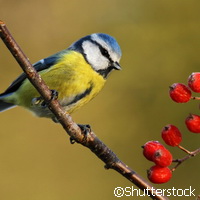Study spotlights social networking in birds
Researchers from the University of Oxford in the United Kingdom say they have found a novel way to assess the social networks that connect individual animals to each other. The way in which animals connect with one another plays an important role in the health and survival of animals, both when they are alone and in groups. The study was presented in the Journal of The Royal Society Interface. Evaluating around one million wild great tits helped the researchers develop this new study approach, which allows periods of intense social activity within many observations to be identified. So the team not only got a more detailed look at the birds but they determined which birds are 'real friends' and which are sizing one another up to mate. This study is unique in that past studies have not been very successful at uncovering the networks of animal societies. 'If you think of the data about you in Facebook it records things like who you are friends with, where you've been, and what you share with others,' said lead author Ioannis Psorakis from the Department of Engineering Science at the University of Oxford. 'What we have shown is that we can analyse data about individual animals, in this case great tits, to construct a 'Facebook for animals' revealing who affiliates with who, who are members of the same group, and which birds are regularly going to the same gatherings or events.' Attaching transponders and sensors that logged the appearance of the tits at bird feeders placed around Wytham Woods, Oxford the team identified the birds that were friends looking for food together. The researchers also observed which birds were starting the process of pairing up or were already in a pair. 'What we've shown is that our technique can extract information about the networks that bind individuals together by sampling and analysing their mobility patterns,' said Mr Psorakis, a doctoral student at the University of Oxford. 'Our approach makes it possible to look at huge amounts of data without having to decide what time resolution is best to extract meaning - the model evaluates this automatically. This is just the first example of how zoologists are beginning to use our method to explore social networks of animals in a 'big data' context.' Initial findings suggest that individual birds do not take part in flocks at random. They actually favour other members of the population that interact with them. According to the researchers, most networks extracted using the approach are strongly clustered, and in such tight bird communities individuals forage together and interact with their current or future mating partner. The findings of this study could give researchers the information they need to better understand the flow of communication between animal populations. Scientists can test how specific social structures support or obstruct the spread of new information from individual to individual.For more information, please visit:University of Oxford:http://www.ox.ac.uk/Journal of The Royal Society Interface:http://rsif.royalsocietypublishing.org/
Countries
United Kingdom



